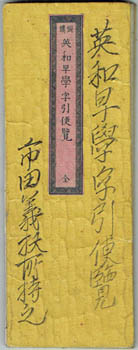
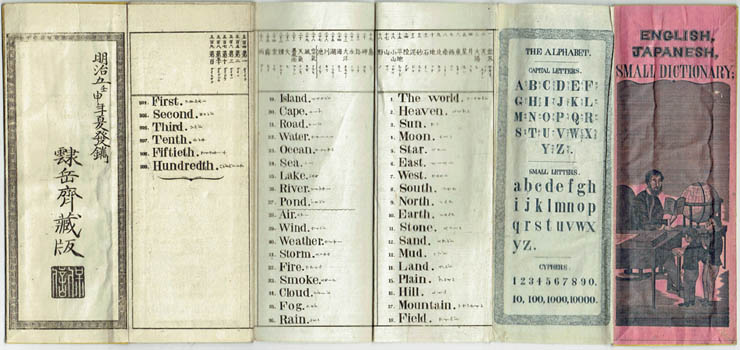

English, Japanesh, Small Dictionary; [Eiwa haya-gaku jibiki Binran]. Tokyo, Osaka? 1872 (Meiji 5). 16x6cm publisher's wrapper with title label; illustrated title in English on red paper, 30pp accordian folding, first page printed in blue. Owner's inscriptions on the covers. A pleasing copy, a most pleasing book. Au$300
Perfect for the narrowest pocket, or sleeve maybe. The explanatory Japanese with each of the 509 entries is tiny and clear. Osaka Women's University has a copy and that's all I could find anywhere. The NDL database lists it only on microfilm as part of a collection of English studies titles issued in the seventies.
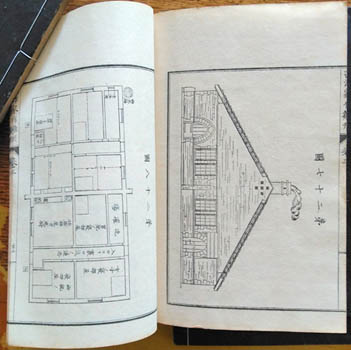
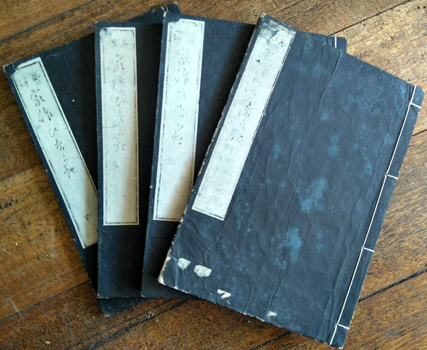
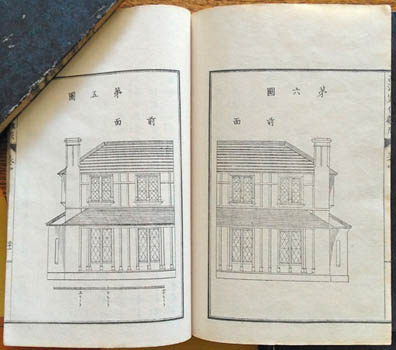
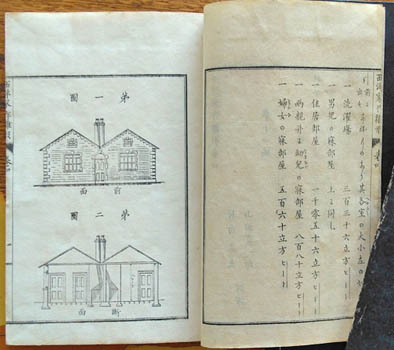

ALLEN, Charles Bruce; Murata Fumio & Yamada Koichiro. [Seiyo Kasaku Hinagata]. Tokyo, Gyokuzando 1872 (Meiji 5). Four volumes 23x15cm publisher's wrappers with printed title labels. Illustrations through the text and full page plates - copper engravings. Labels rubbed and mildly chipped; a rather good copy. Au$1500
The first western architecture book published in Japan. I'm intrigued by the choice of the modest 'Cottage Building, or hints for improving the dwellings of the labouring classes' - one of Weale's utilitarian Rudimentary Treatises. Why not European grandeur? American mass production? Allen's small book first appeared in 1849-50 and remained in print, progressively updated, into the 20th century. This translation was made from the 1867, sixth edition.
A sensible enough choice I guess, but when has sense played any part in the introduction of new ideas? Murata Fumio edited 'Seiyo Bunkenroku' (1869 &c) - based on the reports of the Takenouchi mission of 1862 - which focused on England so the connection is clear enough. That there was any significant group pushing for philanthropic reform this early in the Meiji restoration comes as a surprise to me; perhaps this book was chosen as a slap in the face to the opponents of westernisation and modernisation. Ostensibly it was a response to the 1872 Tokyo fire. Allen's book was given by an Englishman to the translator as useful for information on fire-proof buildings. Could it be that simple?
Worldcat finds no copy outside Japan - Columbia apparently has a later reprint. A search of the specialist libraries I can think of found no more.
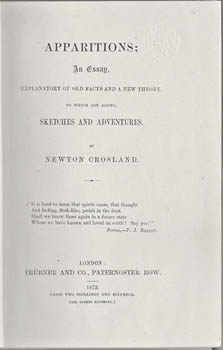
CROSLAND, Newton. Apparitions; An Essay, Explanatory of Old Facts and a New Theory. To which are added, sketches and adventures. London, Trubner 1873. Octavo publisher's cloth (a little rubbed and flecked); [8],166,[2]pp. Au$165
Uncommon; a crusade in the cause of Spiritualism, bellicose but not unfair according to the author: "If I have punished my adversaries, ... [I fight] with the spirit of the pugilist or fencer, and not with the feelings of an enemy". Crosland published a version of his essay in 1856 and has reworked it here, given the developments in Spiritualism - and opposition to Spiritualism - in the intervening years. Appended are three short pieces of fiction, the first, 'Hartsore Hall' is a ghost story.
Crosland's career, in literary terms, is overshadowed by that of his wife - Mrs Newton Crosland oddly enough - but his works were not unambitious; they include his 'New Principia' (1884) in which he overturns Newtonian theories of the universe. He did publish an autobiography late in life (1898) but that has so far eluded me as effectively as his 'Principia'.
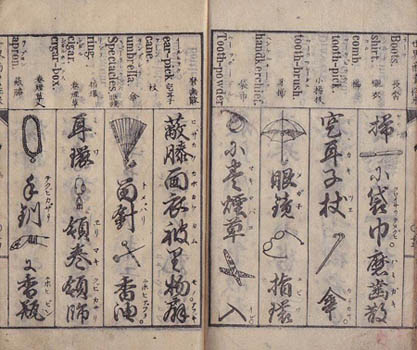
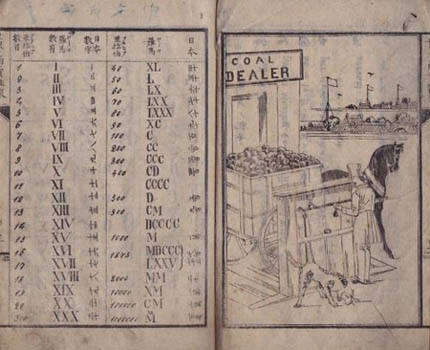

Hashizume Kan'ichi. [Sekai Shobai Orai - literally World Trade Traffic]. Tokyo 1873 [Meiji 6]. 180x120mm publisher's wrapper (title label gone, titled in manuscript on the front cover); 26 double folded leaves; one full page and numerous small illustrations throughout. Au$225
Second edition? - first published in 1871 - of this handy bilingual vocabulary of world trade giving the English, with Japanese explanations, of a wide range of terms, place names, goods, and so on. Hashizume, who specialised in handbooks on trade and on foreign languages, produced, I think, three of these guides for merchants with similar titles. This is the first and the next two supplement this.
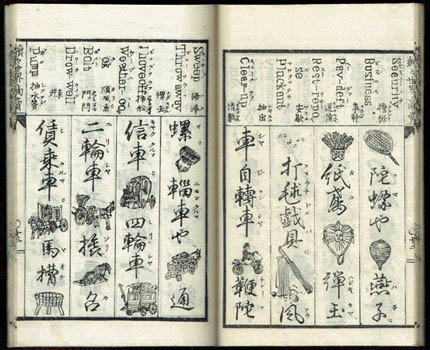
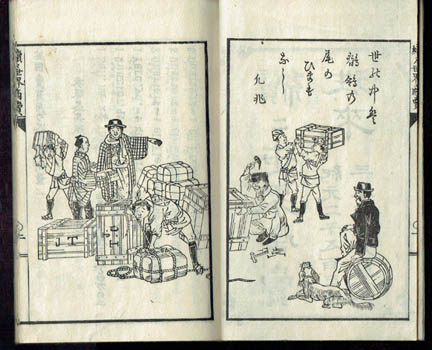

Hashizume Kan'ichi. [Zokuzoku Sekai Shobai Orai]. Tokyo 1873? 180x120mm publisher's wrapper with title label (a bit used); 26 double folded leaves; one double page illustration and several small illustrations through the text, title page framed in a blue barrel. A nice copy. Au$250
First edition? of this handy bilingual vocabulary of world trade giving the English, with Japanese explanations, of a wide range of terms, quantities, goods, professions, and so on. Hashizume, who specialised in handbooks on trade and on foreign languages, produced, I think, maybe four of these guides for merchants with similar titles; the first in 1871 following it up with at least two more in 1873. There are more than three but the variants in copies ostensibly of the same book make it all a bit confusing. Curious about this one is that the English text has been cut in wood, it isn't type. There are several endearing spelling mistakes, mishapen or reversed letters and odd truncations but more puzzling than these are some of the chosen terms for Japanese traders to learn. Sublemate of mercary [sic] makes some sense, as do gloziers, hornessmakers and portruit-painters - but how often did anyone have to discuss velocipedes and grave-diggers?
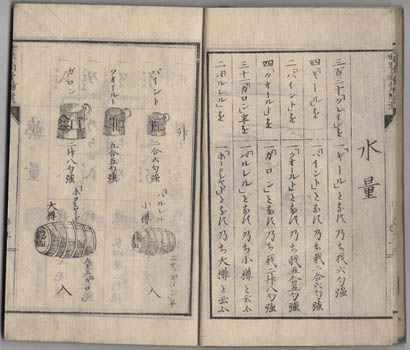
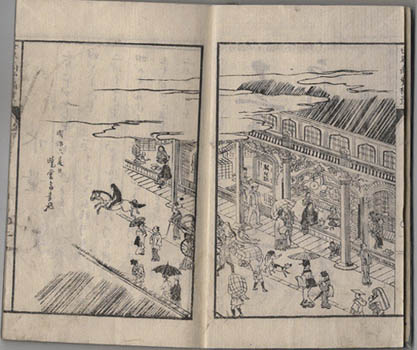

Hashizume Kan'ichi. [Sekai Shobai Orai Hoi]. Tokyo 1873 [Meiji 6]. 180x120mm publisher's wrapper, missing the title label; 23 double folded leaves; one double page and numerous small illustrations throughout. A rather good copy. Au$275
Hashizume made a specialty of handbooks and vocabularies introducing the Japanese to the notion of international trade trade and western languages in the early Meiji period.� In 1871 he published a handy Japanese-English vocabulary of world trade for Japanese merchants dealing with westerners and in 1873 followed up with two companion works. This one, as I understand it, concentrates on sales.
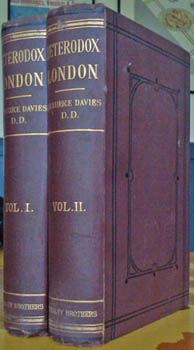
DAVIES, Charles Maurice. Heterodox London: or, Phases of Free Thought in the Metropolis. London, Tinsley 1874. Two volumes octavo publisher's brown cloth blocked in black and gilt. A quite good pair. Au$250
First edition. I must admit I took no notice of Davies' more successful books 'Orthodox London' and 'Unorthodox London' in the past, dismissing them as church stuff. Thanks to an article by Arnold Hunt in the Book Collector, in their handy occasional series 'Uncollected Authors', I learnt that both Davies and his books are more interesting than that.
Davies was an Anglican cleric who turned to scribbling and ended up a disgrace. His 'London' books are frontline, occasionally undercover, reportage of the wild and woolly boomtime spiritual life of London. In 'Heterodox London', apparently the least successful of the series (it never made it into a second edition - the Freethought crowd bought and remaindered a fair number of copies), he has turned to the secularists, the free-thinkers, working-men's associations, radicals, atheists, vegetarians, socialists, spiritualists ... rabble rousers of all creeds. He attends a debate of the Dialectical Society on cremation, listens to Bradlaugh argue away the existence of God, attends a Positivist school. Davies is chatty, amiable, tolerant and thorough and the reader gets the impression that the further he travels from the acceptable the more he likes it. And it seems to have been true.
His final disgrace in the church was not due to any forgiveable heresy - he was accused of the attempted rape of a teenage girl - but he continued to regard himself as a churchman; the minister of an increasingly bizarre personal church. Hunt's article obliges with excerpts from reviews of his books, appreciative to the first but increasingly scathing or indignant as each book appeared. This one was "vulgar, often offensive" and evil in "the undue prominence it gives to nobodies and their very unimportant opinions" (Pall Mall Gazette and Tinsley's Magazine respectively).
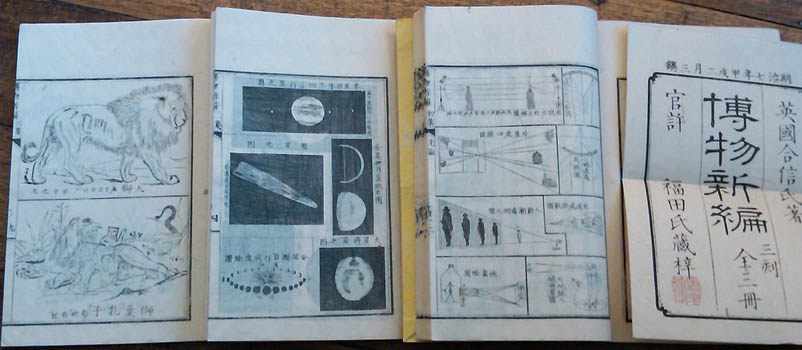
[HOBSON, Benjamin]. [Hakubutsu Shinpen]. Tokyo, 1874 (Meiji 7). Three volumes, 255x173mm, publisher's yellow wrappers with title labels (a bit smudged); wood cut illustrations in all three volumes. Rather good with the original printed outer wrapper loosely inserted and untorn. Au$300
Third edition, it seems, of this adaptation of Hobson's Bo Wu Xin Bian first published in Shanghai in 1855 and in Japan in 1864. Hobson wrote a few primers on science and medicine for the Chinese which were then adapted by the Japanese. This covers physics in the first volume - including such things as optics, electricity and hydraulics; astronomy in the second; and zoology in the third.

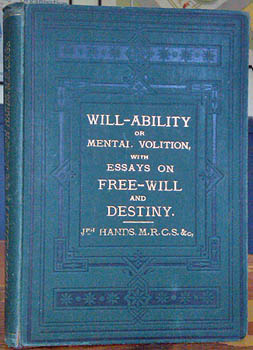

HANDS, Joseph. Will-Ability; or, Mind and its Varied Conditions and Capacities. A dissertation and explanation of the mystery of Will-Ability, Mind-Energy, or Mental Volition, as exercised in controlling ourselves, or the thoughts, feelings, and acts of others; exemplified, especially as to the latter capabilities, by the faculty of Electro-Biology, or Animal Magnetism, and the Influence of Fascination. Illustrated by facts. Also observations on the consequences effected in us through the quality or dominion of Faith and Belief, or Self-Will Operation, as influenced by the phrenological organ of hope, and called into active being, through the agency of education and persuasion, and other means, as Charms, Spells and Amulets, to which are added essays on Free-Will and Fate, Destiny and Inevitable Necessity. London, J. Burns [1875]. Octavo publisher's green cloth blocked in black & titled in gilt; viii,158pp. With a grateful inscription from the author to Miss M. Wait, who transcribed the book; Hands has also made a few additions to the text. Au$400
Can you think of any mid-Victorian fad, hobby-horse or loony fringe preoccupation not covered in the title? Clairvoyancy? Perhaps so but that appears on page two as part of Hands' work treating patients by animal magnetism. Anything missed here probably appears in two of his other books, one on beauty and the laws of its attainment, the other seems to cover the rest of the laws of the universe. He also wrote on homeopathy, isopathy (?), dietetics and promised to write on vaccination (for the affirmative).
Hands was a London homeopath but, knowing nothing more whatsoever about him, all we can add is that this is humanitarian reform; Hands is convinced that practical application of his principles would sweep away 'nearly every species of crime'. Punishment having proved worse than useless, leniency, benevolence and education are necessary.
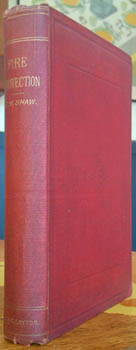
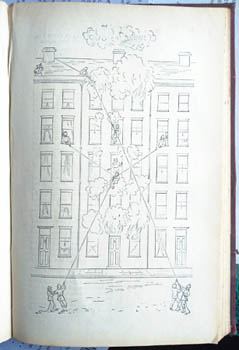
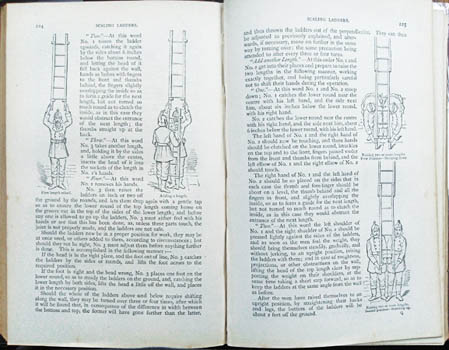

SHAW, Eyre M. Fire Protection. A complete manual of the organization, machinery, discipline, and general working, of the fire brigade of London. London, Charles and Edwin Layton 1876. Octavo publisher's cloth; xiii,332pp and an illustrated 64 page "Appendix of Manufacturers' and other Advertisements, having reference to Fire Protection", numerous illustrations and diagrams, a plate and a double page map. Some foxing at the ends but a rather good copy. Au$800
First edition. Essential in fire fighting history. As far as Shaw was concerned, this was the first attempt in any language "approaching to a complete or comprehensive scheme" to embody the essential principles and practice of fire fighting. In other countries printed manuals "of some kind or another have been in use for many years .. but they are meagre in the extreme and .. altogether useless for the instruction of fire brigades charged with the protection of great commercial cities". Shaw was of course responsible for the modern London fire department, in turn the model for fire departments around the world.
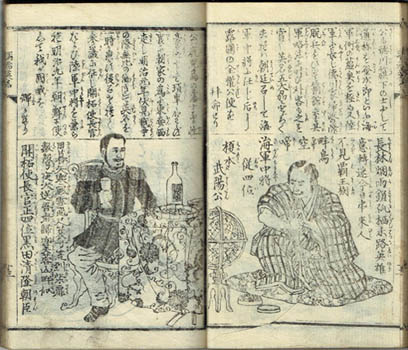
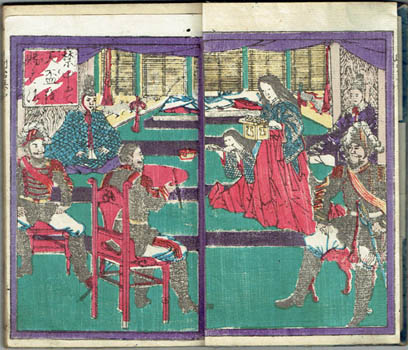
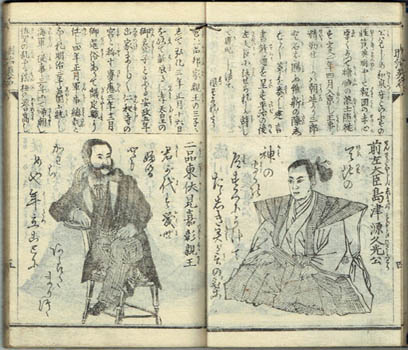
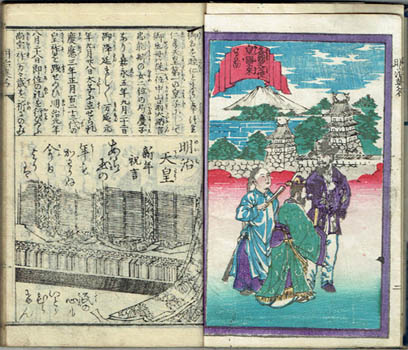

Shinoda Senka & Utagawa Yoshiharu, [Meiji Eimei Hyakueisen]. Tokyo, Murakami 1879? 18x12cm publisher's wrapper with title label; one double page and one full page colour woodcut, 120 half page woodcuts on 60 double folded leaves. Two clean tears across the paste down title page without loss, a well read copy but solid and decent enough. The illustrations, not so well printed, are by Utagawa Yoshiharu. Au$100
A popular, poetic, gallery of famous folk of the Meiji period - the first bit of it anyway. There are the expected statesmen and lords but there are also scholars, a handful of women and what look to to be unsavoury reprobates. Perhaps they are great statesmen. I'm equally ignorant about the verse with each portrait. I presume these aren't cheeky limericks or Clerihews.
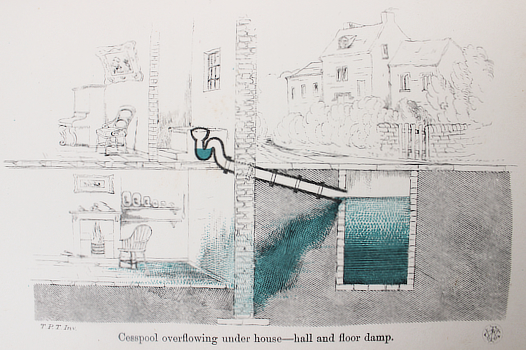
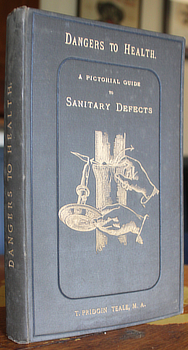
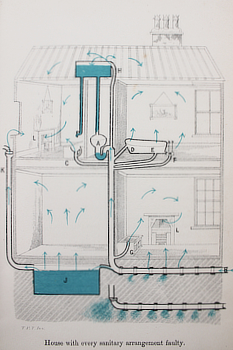
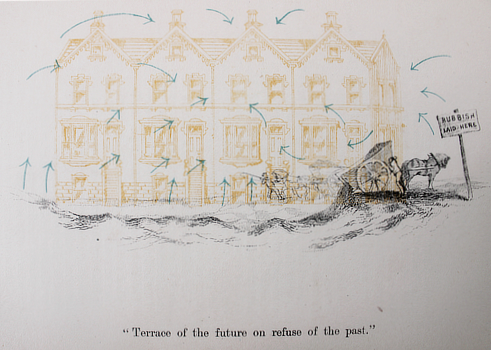

TEALE, T. Pridgin, Dangers to Health: a pictorial guide to domestic sanitary defects. London, Churchill &c 1879. Octavo publisher's gilt decorated illustrated cloth (a touch mottled); 55 plates, all but a couple in black and blue, one in three colours. Minor signs of use, quite good. Au$475
First edition of this charming and terrifying pictorial guide to the perils of Victorian home life. Three more editions and French, German and Spanish translations (at least) followed over the next few years. I recommend this to anyone wanting to restore old houses with absolute authenticity. And it's essential for time travellers.
"Having further traced illness amongst my own patients to scandalous carelessness and gross dishonesty ... I became indignantly alive to the fact that very few houses are safe to live in." A still useful warning. Teale, third generation Leeds surgeon, like so many eminent Victorians, can only have achieved so much by working hundred and sixty hour weeks. There was a deluge of obituaries at his death in 1923, all eulogistic, but the note in the British Medical Journal caught my eye: he had an "almost feminine sweetness of disposition."
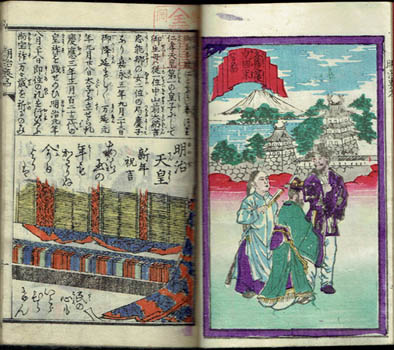

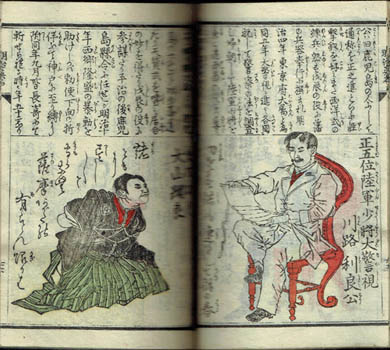
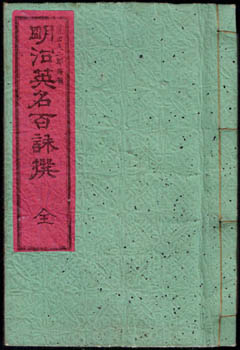

Shinoda Senka & Utagawa Yoshiharu, [Meiji Eimei Hyakueisen]. Tokyo, Murakami 1879. 18x12cm publisher's wrapper with title label; one double page, one full page colour woodcut, 120 half page woodcuts - all but a couple coloured - on 60 double folded leaves. Inscription on the back cover; a nice copy. The illustrations are by Utagawa Yoshiharu. Au$400
First edition and a deluxe coloured copy of this popular, poetic, gallery of famous folk of the Meiji period - the first bit of it anyway. There are the expected statesmen and lords but there are also scholars, a handful of women and what look to to be unsavoury reprobates. Perhaps they are great statesmen. I'm equally ignorant about the verse with each portrait. I presume these aren't cheeky limericks or Clerihews. I don't know how rare coloured copies are but I haven't found another amongst the recorded copies.
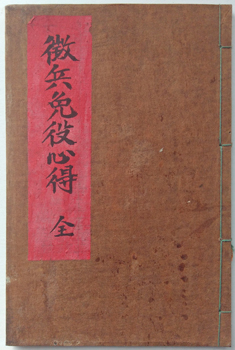
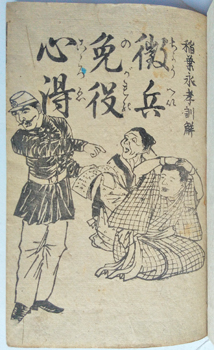
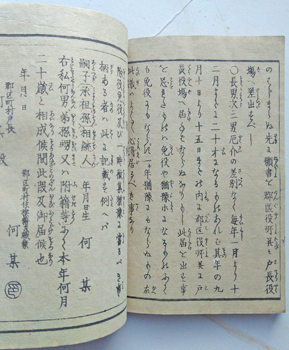

Inaba Eiko. [Chohei Men'eki Kokoroe]. Osaki Naosaburo 1879 (Meiji 12). 17x11cm later wrapper with manuscript title; illustrated title/self wrapper and eight leaves. An excellent copy. Au$500
The draft dodger's handbook: a guide to exemptions from conscription into the new Imperial Army. Conscription rolled out slowly across Japan from 1873 and one of the most useful exemptions was being a first son; which meant a rash of adoptions preferably into a family where conscription hadn't yet arrived. Fukuzawa wrote about "sons who do not know where their fathers live" and I read somewhere that one of Japan's great literary heroes - Soseki maybe? - registered himself in Hokkaido to escape the draft.
Of course money solved everything: an exemption or proxy fee meant that someone else took your place and I would guess that no true aristocrat would dream of having a son drafted; they were already in military school and officer training. So, naturally, peasants filled the draftee ranks and not all peasants were happy about this. There were 'blood tax' riots, the most furious in Okayama where authorities adroitly charged 20,000 rioters, executed a dozen or so and gaoled a few dozen more.
Without money, a good solid disease, disability or an affable sonless family this little pamphlet was your best friend. Worldcat finds no copies and CiNii finds one, at Tokyo University. It's often cited by academics but as they mostly repeat each other's mistakes I doubt many have seen it.
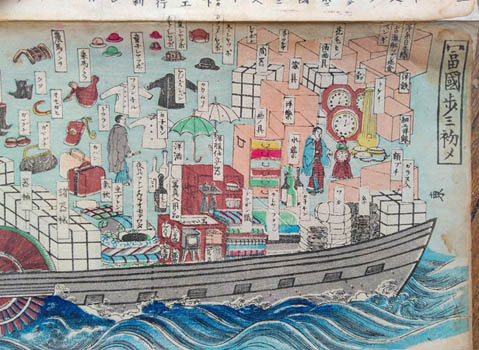
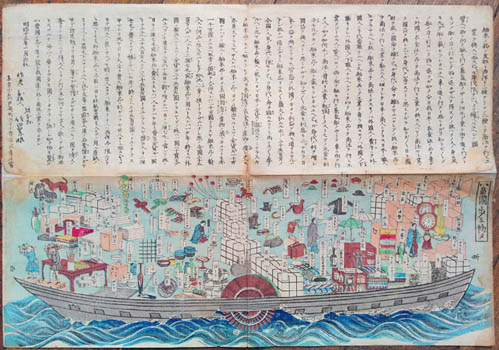
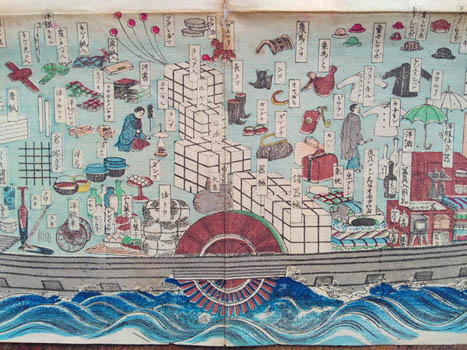
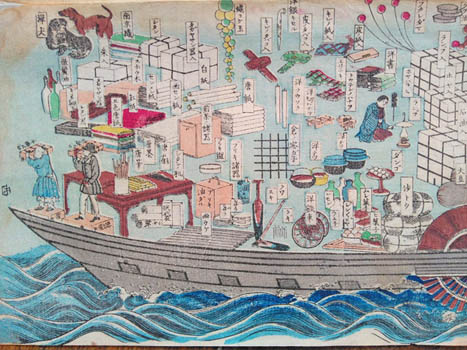

Sada Kaiseki. [Fukoku Ayumi Hajime]. Tokyo, Sada 1880 (Meiji 13). Woodcut broadside 36x52cm, stencil coloured? Expert repairs to the folds at each side and in the centre, some stains. Folded as issued with the outer wrapper woodcut mounted on old paper. Au$950
This captivating woodcut which looks like an advertisement for imported treasures is instead a strident protest and attack on these gewgaws. Sada was a troublesome priest but no reactionary flat-earther, not quite. He wasn't simple. He developed complex theories of science, culture and economics and saw the opening of Japan to this slew of imports as the cause of inflation and hardship for the lower classes. This woodcut was produced to promote the boycott of foreign goods and lists specific targets. Sada spent the last years of his life organising boycott societies and died - in 1882 - on a lecture tour.
The presence of a wrapper with this print suggests to me this was not given away, it was sold. Waseda University illustrates two copies, one in better shape but carelessly coloured compared to this. The other is fairly worm eaten. They do have a wrapper, which, according to the provenance, belongs to their better copy but it is separately catalogued without any mention of Sada. Worldcat finds the NLA copy.
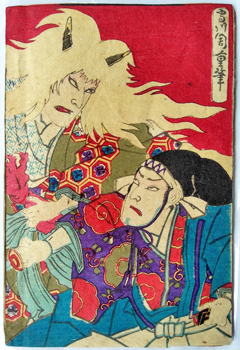
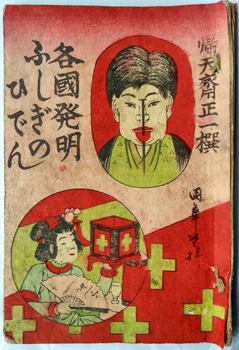
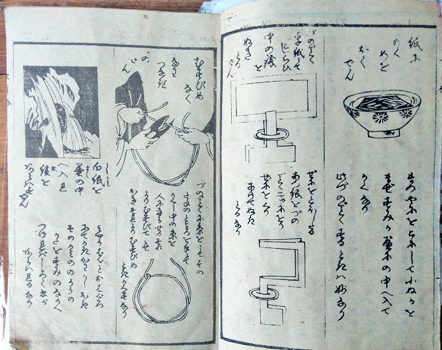
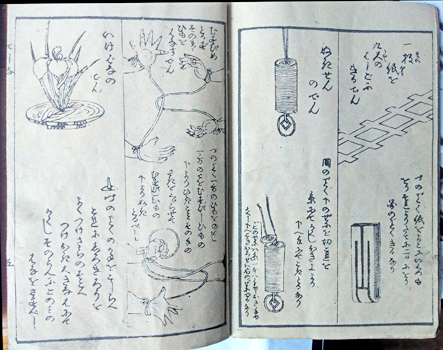

Magic. Kitensai Shoichi : [Kakkoku Hatsumei : Fushigi No Den]. n.p. n.d. [c1880?]. 17x11cm publisher's colour woodcut wrappers, thread tied; 7 folded leaves including wrappers, b/w illustrations on eleven pages. Well thumbed but most acceptable. Au$900
Deservedly thumbed, an appealing little book of mostly western magic tricks that does not teach you, I'm sorry, how to drive a spike through your tongue. Kitensai supposedly learnt western magic in Paris in the early 1870s and brought it back to Japan in the mid to late 1870s; I can't find two writers that agree on dates.
The NDL has copies of another work on western conjuring tricks that appeared in the 1880's with Kitensai listed as first contributor to the earliest, 1882, printing but I can't find a record of our book anywhere. I suspect it was produced for sale at his shows.
The back wrapper might be purposeful or might have been pinched from a popular kabuki thriller about the battle between good and evil being printed across the workshop.
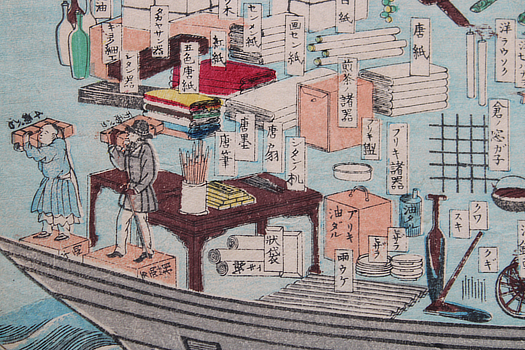
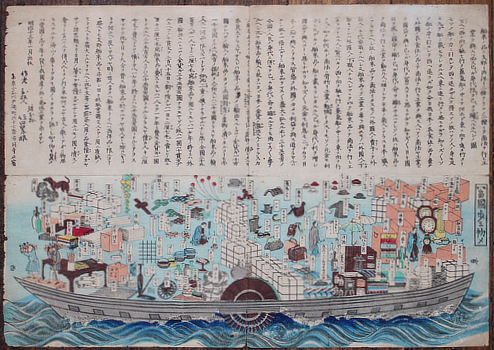
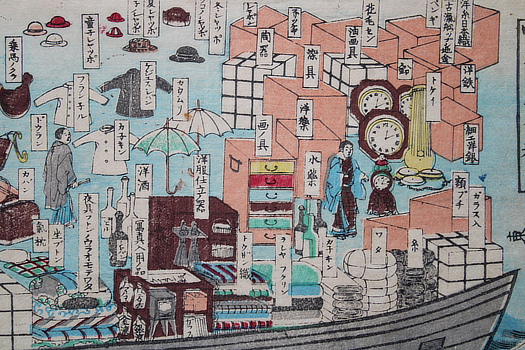
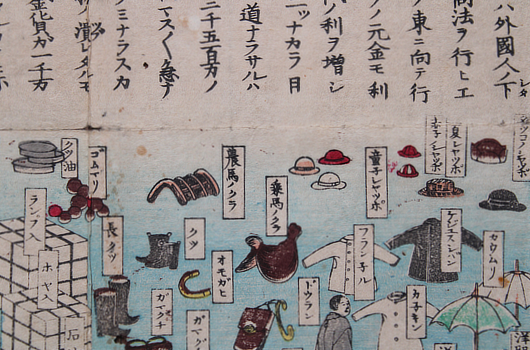

Sada Kaiseki. [Fukoku Ayumi Hajime]. Tokyo, Sada 1880 (Meiji 13). Woodcut broadside 36x52cm, stencil coloured? Some small holes and separation along folds; pretty good, the colour bright. Au$950
This captivating woodcut which looks like an advertisement for imported treasures is instead a strident protest and attack on these gewgaws. Sada was a troublesome priest but no reactionary flat-earther, not quite. He wasn't simple. He developed complex theories of science, culture and economics and saw the opening of Japan to this slew of imports as the cause of inflation and hardship for the lower classes. This woodcut was produced to promote the boycott of foreign goods and lists specific targets. Sada spent the last years of his life organising boycott societies and died - in 1882 - on a lecture tour.
This was issued with an outer wrapper which suggests to me this was not given away, it was sold. Waseda University illustrates two copies, one in better shape but carelessly coloured compared to this. The other is fairly worm eaten. They do have a wrapper, which, according to the provenance, belongs to their better copy but it is separately catalogued without any mention of Sada. Worldcat finds the NLA copy.

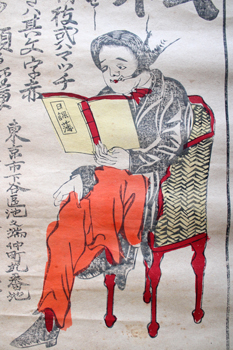
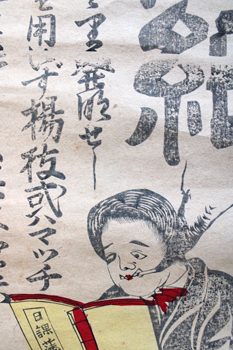
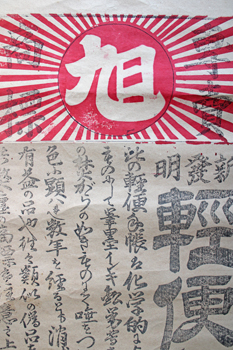

Paper. Toyosha? [Shin Hatsumei Keibenshi]. n.p. [Osaka?] [188-?]. 75x28cm woodcut with added colours. Piece from the top margin well away from the printing, a repaired tear; Quite good for a cheap, vulnerable bit of production. Au$150
I believe this to be an announcement for a new invention of a lightweight paper. I hope not the paper this is printed on which seems heavy and coarse to me. Probably not considering the easy grasp of our newspaper addict. I suspect the cigarettes will stay on that side of his mouth until his left eye looks as sore as the right does now. Then he will switch back.

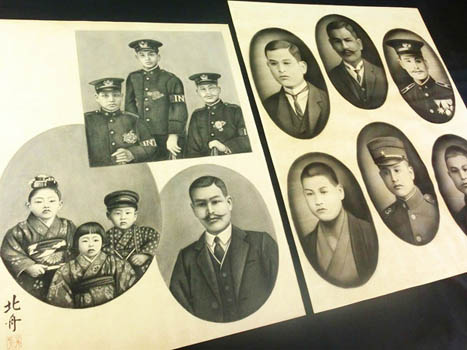
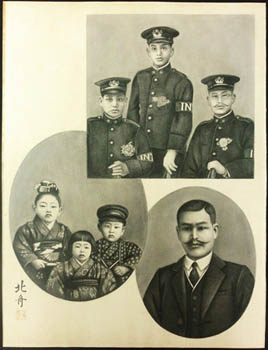


Photography - Japan. Portraits from photographs scrupulously hand painted to impersonate lithographs. n.p. [c1880-1890?]. Two sheets, 54x41cm and 60x48cm, with nine portraits all but one oval; each about 25cm - ten inches - high. Au$450
Are these the ultimate modern one-up-manship in family portraiture? Painted over photos are common enough and paintings from photos equally so but these are large scale, done from scratch purposely to mimic the grain of lithography. The stippling is so painstaking and exact that it would have been easier to make and print lithographs.
By the 1880's reaction to modernity and the west, by nationalists watching their tradition vanish, was strident and often powerful. Don't forget the western design of the residence of the new Imperial Palace was abandoned after earthquake damage to brickwork and the official carpenter took over. No small victory for superior Japanese traditions. The arguments over portraiture and photography are often unexpected, confusing and contradictory to me. Schools that I would think traditionalist welcomed the camera and realism - though some disliked photo portraits for moral or ethical reasons - but whatever the argument the photograph and its wedded industry - portraits painted in oils over or from photos - became ubiquitous essentials for the family shrine.
Our well to do family is not only on the side of western modernity, they go one step further by embracing the foreign technology of the lithographic print. So why hand painted on such a scale? Maybe partly because that's what a prominent family can afford but likely because portraits like this were still private family affairs. According to Conant (Challenging Past and Present), the painter Takahashi - portraitist of the Emperor - was thwarted in his 1880s project to paint portraits of the heroes of the Meiji by families refusing him use of their photographs.
The smaller set of portraits here is signed and sealed Hokushu. The other, clearly of later photos, has an illegible, to me, seal.
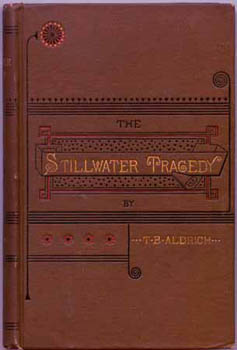
ALDRICH, T.B. The Stillwater Tragedy. Boston, Houghton Mifflin 1880. Octavo, excellent in publisher's brown cloth blocked in gilt, red and black. Au$175
First edition; classic detective fiction and an anti-labour novel, with a murdered corpse at the end of the first chapter and an unjustly suspected hero standing up to thuggish strike leaders. While barely inflammatory - the author and printer did not, after all, have to go into hiding - this novel did stir up more conversation than usual amongst his readers. His readers can't have been expected to take much exception to it: Twain wrote to Aldrich that he had enjoyed reading it in the notorious periodical of Howells and that Mrs Clemens was looking forward to it between baby feeds. The connections between Aldrich and the extreme anti-labor literature of the late 19th century are not hard to trace.
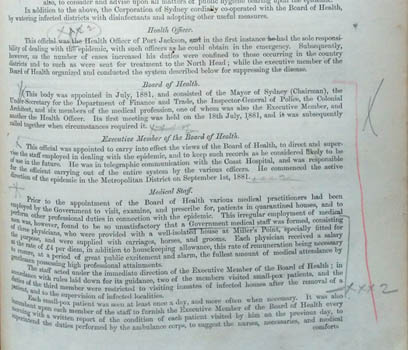
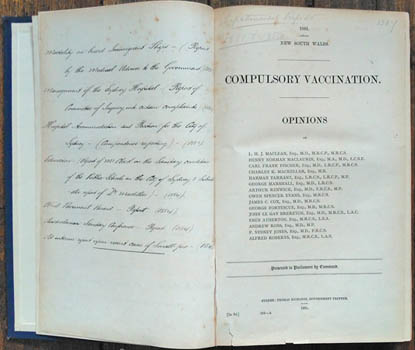

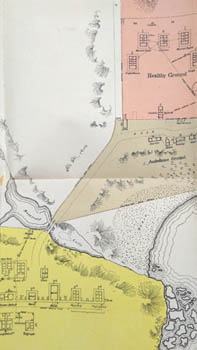

Public health, quarantine & sanitation. A collection of sixteen reports on vaccination, quarantine, disease and sanitation in Sydney. Sydney, Govt printer 1881-84. Foolscap, together in modern cloth. Signs of use, a few short tears, a couple of plans with repairs, minor but for the plan of the Little Bay Sanatorium (with report 12 - a revised version of that with report 6) which is in pieces but all there. Au$950
A modern binding but not a modern gathering: there is a contemporary handwritten list of contents at the front. This has every sign of being compiled by a body like the Board of Health. The Report of the Board on the small-pox epidemic has been extensively marked up and corrected by hand. Each of these is worth its own long maundering note, but. All these papers come in some way out of the small-pox outbreak of 1881-82 and you may not be surprised that it become political real fast. It was a debacle. First among the blameworthy were the Chinese, blamed for introducing the disease, then rightly came the officials, disorganisation, unreadiness and general incompetence top to bottom. The vaccination paper records the lengthy opinions of fifteen esteemed medicos and largely concerns small-pox - still the only vaccination there was. All but John Le Gay Brereton were in favour. He regarded vaccination an evil worse than disease.
Sixteen pages on schools versus 66 pages on wood pavements may seem unbalanced until you read the board's report and the evidence and realise that given how many roads were paved with wood it's a wonder that anyone was alive - not swept away by yellow fever. Thank heaven for Australian hardwoods. The Fijian representative to the 1884 conference couldn't make it - the steamer bringing the invitation was placed in quarantine.
(1) Compulsory Vaccination. Opinions of ... ; 55pp; (2) Report of the Royal Commission ... upon the management of the Quarantine Station, North Head, and the Hulk "Faraway"; (xiv),118pp; (3) Second Report ... Quarantine Station ... ; 13pp and folding plan; (4) Instructions to the Assistant Health Officer, stationed at Watson's Bay. 3pp; (5) Quarantine Station, North Head. (Report of Health Officer upon state and conditions ... ; 14pp and five plans, three folding; (6) Report of the Board of Health Upon the Late Epidemic of Small Pox, 1881-1882; 20pp and two large folding plans; (7) Quarantining of Steamship "Gunga"; 52pp; (8) Quarantine of Mail-Steamer "Rome" (Correspondence); 8pp; (9) Board of Health (Attendance of Members of, and Subjects ... ; 2pp; (10) Mortality on Board Immigrant Ships. (Report by Medical Officer ...); 2pp; (11) Management of the Sydney Hospital (Report of Committee of Inquiry into Certain Complaints); 27pp; (12) Hospital Accomodation and Position for the City of Sydney; 10pp and large folding plan; (13) Report of Dr. Clark on the Sanitary Condition of the Public Schools in the City of Sydney, and Suburbs; 16pp; (14) Wood Pavement Board. Report, minutes of proceedings, and appendix; 66pp; (15) The Australasian Sanitary Conference of Sydney ... 1884. Report, minutes of proceedings, and appendix. 70pp and five large folding maps and plans; (16) Ad Interim Report Upon Recent Cases of Small-Pox. 6pp.
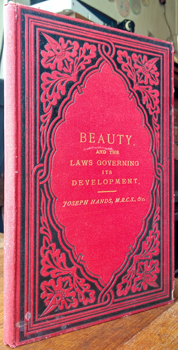
HANDS, Joseph. Beauty, and the Laws Governing its Development; with suggestions on education, relative to the attainment of beauty. London, E.W. Allen [1882?] with overlaid ticket of the Chicago National Institute of Science. Slender octavo, publisher's decorated red cloth blocked in black and gilt; 88pp. A couple of minor flaws to the cloth, rather good. Au$300
Only edition and elusive; just like describing Hands' writings in a simple and clear way. Hands was a London physician cum homeopath, apparently still respectable - viz his membership of the Royal College of Surgeons presuming his claim is true - and wrote works best, or most easily, described as thoroughly Victorian lunatic fringe: on will-ability and mind-energy, on the laws of matter and motion, and here, on aesthetics.
Hands begins with seven aphorisms, one of which was Hogarth's, all sensible enough; the last is quite noble. But from there he leaps from the ideal human form (5'10" tall for man; 5'6'' for woman) to electro-polar action to colour to the lapse of time like an ibex in the high alps and following him leaves us breathless and bewildered.
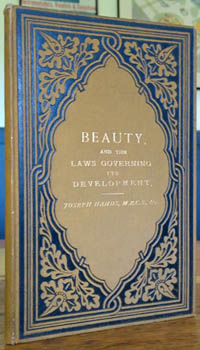
HANDS, Joseph. Beauty, and the Laws Governing its Development; with suggestions on education, relative to the attainment of beauty. London, E.W. Allen [1882?]. Slender octavo, very good in publisher's decorated ochre cloth blocked in black and gilt; 88pp. Au$475
Only edition and elusive, just like describing Hands' writings in a simple and clear way. Hands was a London physician cum homeopath, apparently still respectable - viz his membership of the Royal College of Surgeons presuming his claim is true - and wrote works best, or most easily, described as thoroughly Victorian lunatic fringe: on will-ability and mind-energy, on the laws of matter and motion, and here, on aesthetics.
Hands begins with seven aphorisms, one of which was Hogarth's, all sensible enough; the last is quite noble. But from there he leaps from the ideal human form (5'10" tall for man; 5'6'' for woman) to electro-polar action to colour to the lapse of time like an ibex in the high alps and following him leaves us breathless and bewildered.
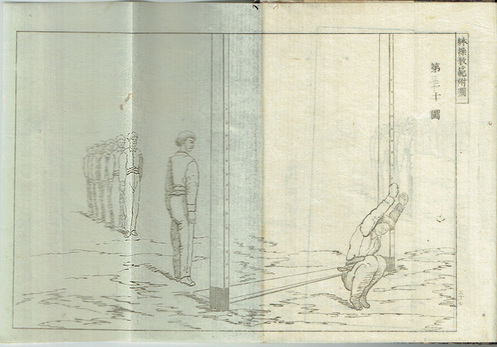
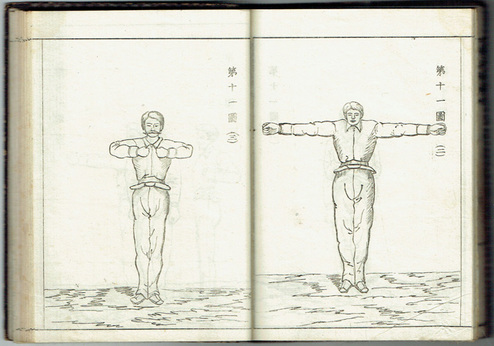
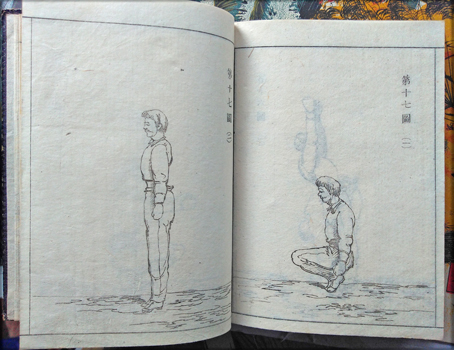
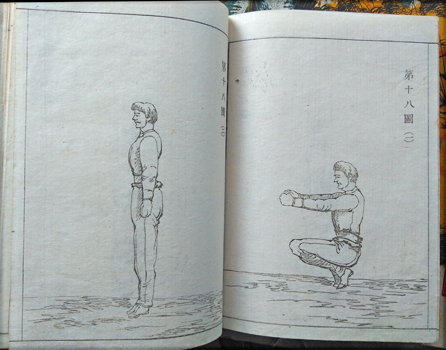

Japan - gymnastics. [Taiso Kyohan - Manual of Gymnastics]. Ministry of War, 1884 (Meiji 17). 150x110mm in what appear to be original cloth backed boards (spine a touch nibbled); 37 double folded leaves (ie 74pp) and 73 full page illustrations (5 folding) numbered to 32 with several bis. A little worming, nothing notable, and a couple of small stains; a quite good fresh copy. Possibly lithographed throughout. Au$300
The Japanese first got in French experts on military physical training in the late 1860s and the first Japanese book I've been able to trace was a translation of part of an 1847 manual the French visitors brought with them. That is I've traced mention of it, not the book itself. This manual also has the look of coming from a French manual but, being light on in French gymnastic manuals of the mid nineteenth century here, I don't know which one. Certainly it models the fine mustachios that became de rigueur for dashing Japanese officers.
The Taiso Kyohan apparently also became the model for gymnastics in secondary schools as the idea of physical education was introduced into Japan. There were many editions of the Taiso Kyohan, presumably updated and changed as the decades went on but I'm unable to trace any copy this early in a library catalogue.
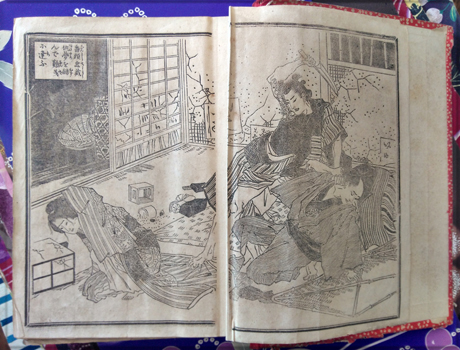
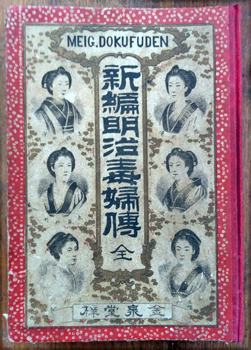
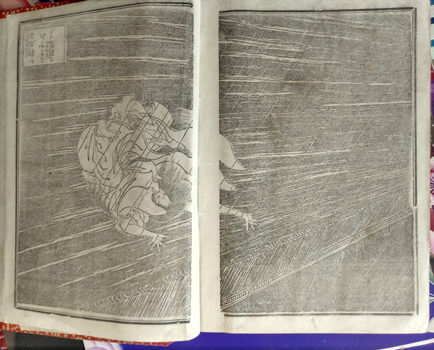
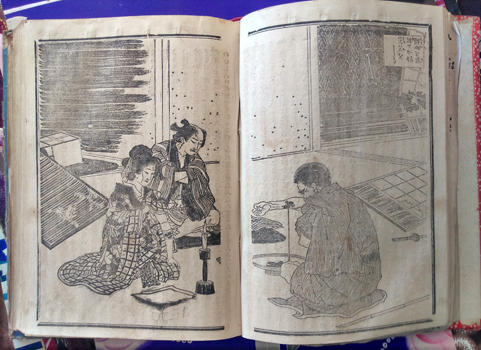

Suzuki Kinjiro. Meig. Dokufuden - [Shinpen Meiji Dokufuden]. Tokyo, Kinsendo 1887 [Meiji 20]. 18x13cm publisher's cloth backed illustrated boards (edges worn); one single page and several double page illustrations. Inner front hinge separated, inner back hinge cracked; maybe missing the front endpaper and the first two leaves (illustrations) are creased; two leaves sprung. A read copy I'm sorry to say, but for one of these flimsy board books made to be read to pieces, still acceptable. Au$150
Second edition? But how many were there? First published in December 1886 this copy is dated November 1887 but is a different book from the copy of the same date illustrated by the NDL. Starting at the front: the cover has been redrawn, the contents are a different printing with different pagination, in a different order and the illustrations are not all the same. The pagination is a nightmare; it starts, stops, jumps forward and back and nowhere meets the NDL November 1887 copy until we get to the last page.
One the prizes of the dokufu craze of the early Meiji. dokufu - poisonous women - are nothing new of course but the happy conjunction at the advent of mass circulation newspapers of a beautifully timed series of murders by unvirtuous young women set the sensation mongers and their readers all of a fever. Newspaper to book, lurid print to kabuki and back again, dokufu were all the rage for a couple of decades. Along the way crime fiction was born and, in a way, modern Japanese literature.
This went to press too soon for Hanai Oume - 1887's murderess of choice - but I don't doubt her case sparked this new edition; she was sentenced in November. Takahashi Oden, Yoarashi Okinu, Torioi Omatsu, Gonsai Otatsu, Ibaraki Otaki and Kaminari Oshin provide plenty to go on with.
Worldcat finds no copies of any but a modern reprint outside the NDL and it was some consolation to see that this copy is a lot better than one reproduced online by the NDL.
  1 2 [3] 4 5 6 1 2 [3] 4 5 6   |